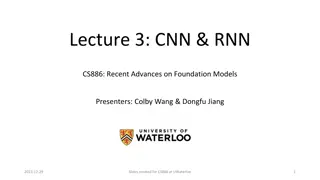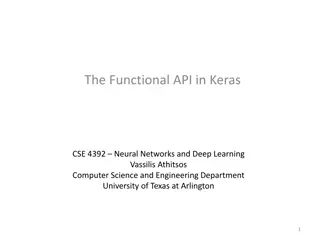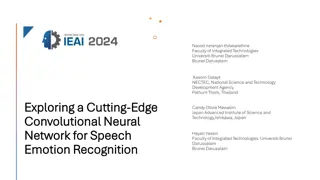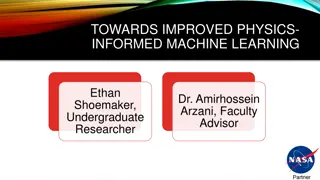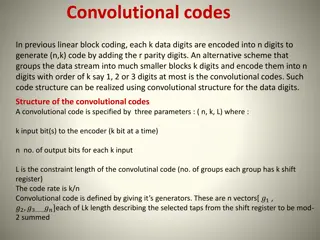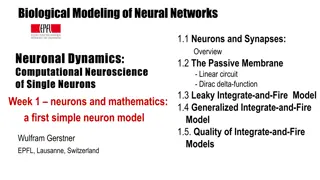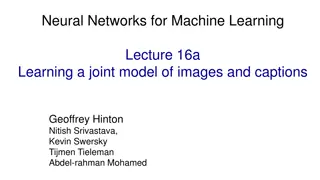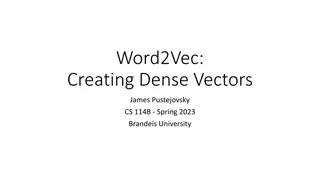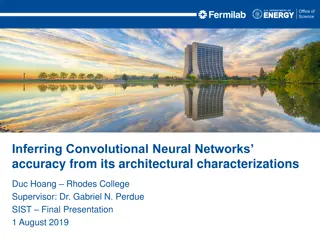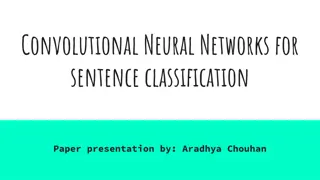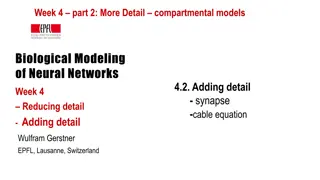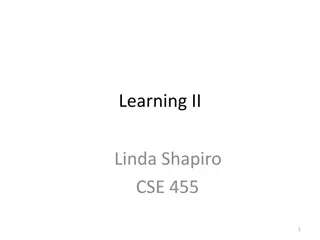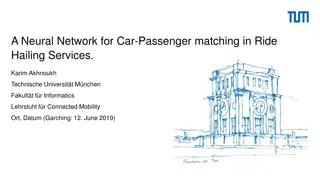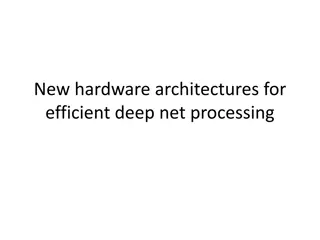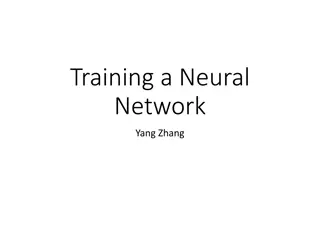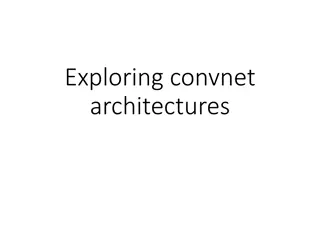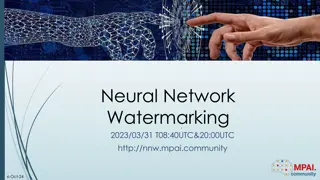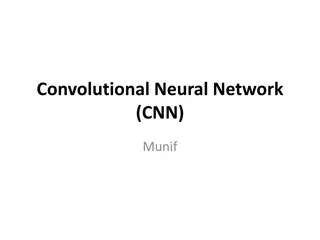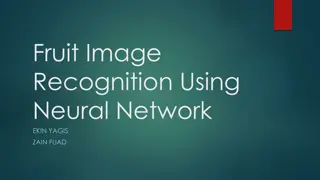Rainfall-Runoff Modelling Using Artificial Neural Network: A Case Study of Purna Sub-catchment, India
Rainfall-runoff modeling is crucial in understanding the relationship between rainfall and runoff. This study focuses on developing a rainfall-runoff model for the Upper Tapi basin in India using Artificial Neural Networks (ANNs). ANNs mimic the human brain's capabilities and have been widely used i
0 views • 26 slides
Understanding Recurrent Neural Networks (RNN) and Long Short-Term Memory (LSTM)
Recurrent Neural Networks (RNNs) and Long Short-Term Memory (LSTM) are powerful tools for sequential data learning, mimicking the persistent nature of human thoughts. These neural networks can be applied to various real-life applications such as time-series data prediction, text sequence processing,
15 views • 34 slides
Localised Adaptive Spatial-Temporal Graph Neural Network
This paper introduces the Localised Adaptive Spatial-Temporal Graph Neural Network model, focusing on the importance of spatial-temporal data modeling in graph structures. The challenges of balancing spatial and temporal dependencies for accurate inference are addressed, along with the use of distri
3 views • 19 slides
Graph Neural Networks
Graph Neural Networks (GNNs) are a versatile form of neural networks that encompass various network architectures like NNs, CNNs, and RNNs, as well as unsupervised learning models such as RBM and DBNs. They find applications in diverse fields such as object detection, machine translation, and drug d
2 views • 48 slides
Recent Advances in RNN and CNN Models: CS886 Lecture Highlights
Explore the fundamentals of recurrent neural networks (RNNs) and convolutional neural networks (CNNs) in the context of downstream applications. Delve into LSTM, GRU, and RNN variants, alongside CNN architectures like ConvNext, ResNet, and more. Understand the mathematical formulations of RNNs and c
1 views • 76 slides
Understanding Keras Functional API for Neural Networks
Explore the Keras Functional API for building complex neural network models that go beyond sequential structures. Learn how to create computational graphs, handle non-sequential models, and understand the directed graph of computations involved in deep learning. Discover the flexibility and power of
1 views • 12 slides
Exploring a Cutting-Edge Convolutional Neural Network for Speech Emotion Recognition
Human speech is a rich source of emotional indicators, making Speech Emotion Recognition (SER) vital for intelligent systems to understand emotions. SER involves extracting emotional states from speech and categorizing them. This process includes feature extraction and classification, utilizing tech
1 views • 15 slides
Understanding Artificial Neural Networks From Scratch
Learn how to build artificial neural networks from scratch, focusing on multi-level feedforward networks like multi-level perceptrons. Discover how neural networks function, including training large networks in parallel and distributed systems, and grasp concepts such as learning non-linear function
1 views • 33 slides
A Deep Dive into Neural Network Units and Language Models
Explore the fundamentals of neural network units in language models, discussing computation, weights, biases, and activations. Understand the essence of weighted sums in neural networks and the application of non-linear activation functions like sigmoid, tanh, and ReLU. Dive into the heart of neural
0 views • 81 slides
Assistive Speech System for Individuals with Speech Impediments Using Neural Networks
Individuals with speech impediments face challenges with speech-to-text software, and this paper introduces a system leveraging Artificial Neural Networks to assist. The technology showcases state-of-the-art performance in various applications, including speech recognition. The system utilizes featu
1 views • 19 slides
Advancing Physics-Informed Machine Learning for PDE Solving
Explore the need for numerical methods in solving partial differential equations (PDEs), traditional techniques, neural networks' functioning, and the comparison between standard neural networks and physics-informed neural networks (PINN). Learn about the advantages, disadvantages of PINN, and ongoi
0 views • 14 slides
Understanding Convolutional Codes in Digital Communication
Convolutional codes provide an efficient alternative to linear block coding by grouping data into smaller blocks and encoding them into output bits. These codes are defined by parameters (n, k, L) and realized using a convolutional structure. Generators play a key role in determining the connections
0 views • 19 slides
Exploring Biological Neural Network Models
Understanding the intricacies of biological neural networks involves modeling neurons and synapses, from the passive membrane to advanced integrate-and-fire models. The quality of these models is crucial in studying the behavior of neural networks.
0 views • 70 slides
Exploring Neural Quantum States and Symmetries in Quantum Mechanics
This article delves into the intricacies of anti-symmetrized neural quantum states and the application of neural networks in solving for the ground-state wave function of atomic nuclei. It discusses the setup using the Rayleigh-Ritz variational principle, neural quantum states (NQSs), variational pa
0 views • 15 slides
Automated Melanoma Detection Using Convolutional Neural Network
Melanoma, a type of skin cancer, can be life-threatening if not diagnosed early. This study presented at the IEEE EMBC conference focuses on using a convolutional neural network for automated detection of melanoma lesions in clinical images. The importance of early detection is highlighted, as exper
0 views • 34 slides
Learning a Joint Model of Images and Captions with Neural Networks
Modeling the joint density of images and captions using neural networks involves training separate models for images and word-count vectors, then connecting them with a top layer for joint training. Deep Boltzmann Machines are utilized for further joint training to enhance each modality's layers. Th
4 views • 19 slides
Understanding Spiking Neurons and Spiking Neural Networks
Spiking neural networks (SNNs) are a new approach modeled after the brain's operations, aiming for low-power neurons, billions of connections, and high accuracy training algorithms. Spiking neurons have unique features and are more energy-efficient than traditional artificial neural networks. Explor
3 views • 23 slides
Understanding Word2Vec: Creating Dense Vectors for Neural Networks
Word2Vec is a technique used to create dense vectors to represent words in neural networks. By distinguishing target and context words, the network input and output layers are defined. Through training, the neural network predicts target words and minimizes loss. The hidden layer's neuron count dete
7 views • 12 slides
Introduction to Neural Networks in IBM SPSS Modeler 14.2
This presentation provides an introduction to neural networks in IBM SPSS Modeler 14.2. It covers the concepts of directed data mining using neural networks, the structure of neural networks, terms associated with neural networks, and the process of inputs and outputs in neural network models. The d
0 views • 18 slides
Recent Developments on Super-Resolution: A Comprehensive Overview
Super-resolution technology aims to reconstruct high-resolution images from low-resolution inputs, with applications in video surveillance, medical diagnosis, and remote sensing. Various convolutional neural network (CNN) models have been developed, such as SRCNN, VDSR, ESPCN, and FSRCNN, each with
0 views • 12 slides
Understanding U-Net: A Convolutional Network for Image Segmentation
U-Net is a convolutional neural network designed for image segmentation. It consists of a contracting path to capture context and an expanding path for precise localization. By concatenating high-resolution feature maps, U-Net efficiently handles information loss and maintains spatial details. The a
0 views • 8 slides
EEG Conformer: Convolutional Transformer for EEG Decoding and Visualization
This study introduces the EEG Conformer, a Convolutional Transformer model designed for EEG decoding and visualization. The research presents a cutting-edge approach in neural systems and rehabilitation engineering, offering advancements in EEG analysis techniques. By combining convolutional neural
1 views • 6 slides
Detecting Image Steganography Using Neural Networks
This project focuses on utilizing neural networks to detect image steganography, specifically targeting the F5 algorithm. The team aims to develop a model that is capable of detecting and cleaning hidden messages in images without relying on hand-extracted features. They use a dataset from Kaggle co
0 views • 23 slides
Understanding Convolutional Neural Networks: Architectural Characterizations for Accuracy Inference
This presentation by Duc Hoang from Rhodes College explores inferring the accuracy of Convolutional Neural Networks (CNNs) based on their architectural characterizations. The talk covers the MINERvA experiment, deep learning concepts including CNNs, and the significance of predicting CNN accuracy be
0 views • 21 slides
Convolutional Neural Networks for Sentence Classification: A Deep Learning Approach
Deep learning models, originally designed for computer vision, have shown remarkable success in various Natural Language Processing (NLP) tasks. This paper presents a simple Convolutional Neural Network (CNN) architecture for sentence classification, utilizing word vectors from an unsupervised neura
0 views • 15 slides
Understanding Advanced Classifiers and Neural Networks
This content explores the concept of advanced classifiers like Neural Networks which compose complex relationships through combining perceptrons. It delves into the workings of the classic perceptron and how modern neural networks use more complex decision functions. The visuals provided offer a cle
0 views • 26 slides
Understanding Neural Processing and the Endocrine System
Explore the intricate communication network of the nervous system, from nerve cells transmitting messages to the role of dendrites and axons in neural transmission. Learn about the importance of insulation in neuron communication, the speed of neural impulses, and the processes involved in triggerin
0 views • 24 slides
Exploring Compartmental Models and Adding Detail in Neural Network Biological Modeling
Week 4 delves into compartmental models and the addition of synaptic and cable equation details in biological modeling of neural networks. The content is presented by Wulfram Gerstner from EPFL, Lausanne, Switzerland, providing insights into reducing and adding complexity for a comprehensive underst
0 views • 55 slides
Understanding Neural Network Learning and Perceptrons
Explore the world of neural network learning, including topics like support vector machines, unsupervised learning, and the use of feed-forward perceptrons. Dive into the concepts of gradient descent and how it helps in minimizing errors in neural networks. Visualize the process through graphical ex
0 views • 54 slides
Neural Network for Car-Passenger Matching in Ride-Hailing Services by Karim Akhnoukh
In his M.Sc. thesis, Karim Akhnoukh explores the use of a neural network for car-passenger matching in ride-hailing services. The research delves into solving complex optimization problems related to vehicle routing and passenger matching using innovative algorithms. The study showcases the applicat
0 views • 33 slides
Neural Network Control for Seismometer Temperature Stabilization
Utilizing neural networks, this project aims to enhance seismometer temperature stabilization by implementing nonlinear control to address system nonlinearities. The goal is to improve control performance, decrease overshoot, and allow adaptability to unpredictable parameters. The implementation of
0 views • 24 slides
Machine Learning and Artificial Neural Networks for Face Verification: Overview and Applications
In the realm of computer vision, the integration of machine learning and artificial neural networks has enabled significant advancements in face verification tasks. Leveraging the brain's inherent pattern recognition capabilities, AI systems can analyze vast amounts of data to enhance face detection
0 views • 13 slides
Exploring Efficient Hardware Architectures for Deep Neural Network Processing
Discover new hardware architectures designed for efficient deep neural network processing, including SCNN accelerators for compressed-sparse Convolutional Neural Networks. Learn about convolution operations, memory size versus access energy, dataflow decisions for reuse, and Planar Tiled-Input Stati
0 views • 23 slides
Understanding Neural Network Training and Structure
This text delves into training a neural network, covering concepts such as weight space symmetries, error back-propagation, and ways to improve convergence. It also discusses the layer structures and notation of a neural network, emphasizing the importance of finding optimal sets of weights and offs
0 views • 31 slides
Exploring Variability and Noise in Neural Networks
Understanding the variability of spike trains and sources of variability in neural networks, dissecting if variability is equivalent to noise. Delving into the Poisson model, stochastic spike arrival, and firing, and biological modeling of neural networks. Examining variability in different brain re
0 views • 71 slides
Unveiling Convolutional Neural Network Architectures
Delve into the evolution of Convolutional Neural Network (ConvNet) architectures, exploring the concept of "Deeper is better" through challenges, winner accuracies, and the progression from simpler to more complex designs like VGG patterns and residual connections. Discover the significance of layer
0 views • 22 slides
Understanding Neural Network Watermarking Technologies
Neural networks are being deployed in various domains like autonomous systems, but protecting their integrity is crucial due to the costly nature of machine learning. Watermarking provides a solution to ensure traceability, integrity, and functionality of neural networks by allowing imperceptible da
0 views • 15 slides
Understanding Convolutional Neural Networks (CNN) in Depth
CNN, a type of neural network, comprises convolutional, subsampling, and fully connected layers achieving state-of-the-art results in tasks like handwritten digit recognition. CNN is specialized for image input data but can be tricky to train with large-scale datasets due to the complexity of replic
0 views • 22 slides
Fruit Image Recognition Using Neural Network by Ekin Yagis & Zain Fuad
Explore the process of fruit image recognition using neural networks, including error functions, data pre-processing, neural network structures, results, and the best networks identified. The research delves into techniques like standardizing data and optimizing network architectures.
0 views • 7 slides
Understanding Deep Generative Bayesian Networks in Machine Learning
Exploring the differences between Neural Networks and Bayesian Neural Networks, the advantages of the latter including robustness and adaptation capabilities, the Bayesian theory behind these networks, and insights into the comparison with regular neural network theory. Dive into the complexities, u
0 views • 22 slides




